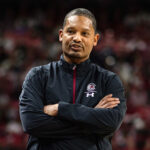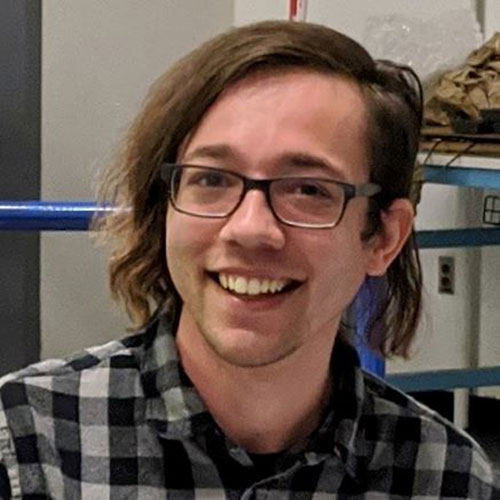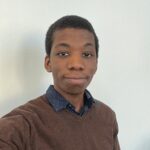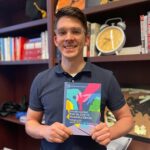
Physics alumnus becomes lead author on collaborative, peer-reviewed paper on diffusion diodes

Centered around research he conducted as a student mentor during the summer of 2019, physics alumnus Chase Fuller ’19 became the lead author on a paper published this past January. Titled “Light-Sensitive Diffusion Diodes for Reaction-Diffusion Waves,” the article investigates the propagation of reaction-diffusion waves through one-dimensional channels. The paper was published in the International Journal of Unconventional Computing (IJUC) and co-written with physics and computer science alumnus Daniel Cohen-Cobos ’23, Niklas Manz, associate professor of physics, and John Lindner, professor emeritus of physics.
Reaction-diffusion waves are reactions that move through diffusion; a common example is how the scent molecules of a stationary candle can spread across a living room, filling the space, Fuller explained. Applying this concept to chemical waves, he was interested in exploring how the direction of reaction-diffusion waves can be manipulated. “We simulated a chemical excitation wave traveling through a liquid via diffusion. We showed that by altering the rate of diffusion in a particular way, a chemical wave can travel in one direction across the region of enhanced diffusion, but not in the other” Fuller explained. This discovery has many implications within physics, Fuller noted, but he was particularly captivated by how it could impact unconventional or alternative ways of computing; a chemical reaction-diffusion system can be used as a computer and the diodes they discovered could be important components for designing an unconventional, chemical computer.
Fuller’s research was conducted alongside math alumna Margaret McGuire ’20 and physics alumna Yang (Fish) Yu ’21. The three students were part of the National Science Foundation Research Experience for Undergraduates (NSF-REU) program and funded by a grant from the Sherman-Fairchild Foundation. Founded in 1955, the Sherman-Fairchild Foundation supports the work of higher education and cultural institutions. “The Sherman-Fairchild grant was priceless because we could hire three Wooster students, including Chase as a student mentor. This combination created a very productive group of motivated students,” Manz reflected.
While Fuller had just graduated the May prior, he wasn’t feeling quite ready to leave Wooster behind, noting that “the chance to stick around for a summer felt like an easier way to say goodbye to my home for four years.” Emphasizing the importance of researching outside of the classroom, Fuller commented that “grants like these allow undergraduate students to step outside the confines of a classroom and cut their teeth on projects that are much more like real-world projects. This is a necessary part of the liberal arts education.” Following their summer of research in 2019, Fuller, McGuire, and Yu all presented their findings at a conference at Miami University and at the regional and national American Physical Society meetings.
With his publication, Fuller joins McGuire and Yu in becoming lead authors on articles about their sophomore research published in a peer-reviewed journal. McGuire studied “geographic tongue,” or the evolution of waves on the human tongue, using reaction-diffusion equations to replicate patterns. This work culminated with an article published in Chaos: An Interdisciplinary Journal of Nonlinear Science in March 2021. Yu’s research considered how reaction-diffusion waves react and move through different obstacles; her paper was published in the Physica A in December 2020.
Lindner reflected on the achievements of that summer, sharing that “This work was guided by Niklas’ deep knowledge of reaction-diffusion research and my expertise in computational physics. It was successful due to the dedication and diligence of our three terrific students.”
Fuller is now pursuing a doctorate in physics at the University of Iowa and attributes his current success to the experience at Wooster. “Without the additional research experience from that summer and many hours of individual attention from Niklas and John, I doubt I’d be as successful in my current program as I am. I’m nearing the end of my fourth year of graduate school, and in that time I have contributed meaningfully to several publications” he said.
In addition to the summer research team, Fuller notes that the publication was made possible through the contributions of Cohen-Cobos, Manz’s co-curricular research assistant. As Fuller left Wooster for graduate school, he and Cohen-Cobos met weekly via Zoom to acquire the remaining results. “Some of the figures in the paper would not exist without him,” Fuller credited. “I’m eternally grateful to Niklas and John for contributing their weekend hours and midnight oil for so long after I had graduated to see that the research was published. They didn’t have to, but they did” Fuller said.
Posted in News on April 17, 2024.
Related Posts
Related Areas of Study
Chemical Physics
An interdisciplinary approach to the fields of chemistry and physics using mathematical techniques
MajorPhysics
With one-on-one guidance from a faculty mentor, every physics major completes independent research in a year-long research project
Major Minor

